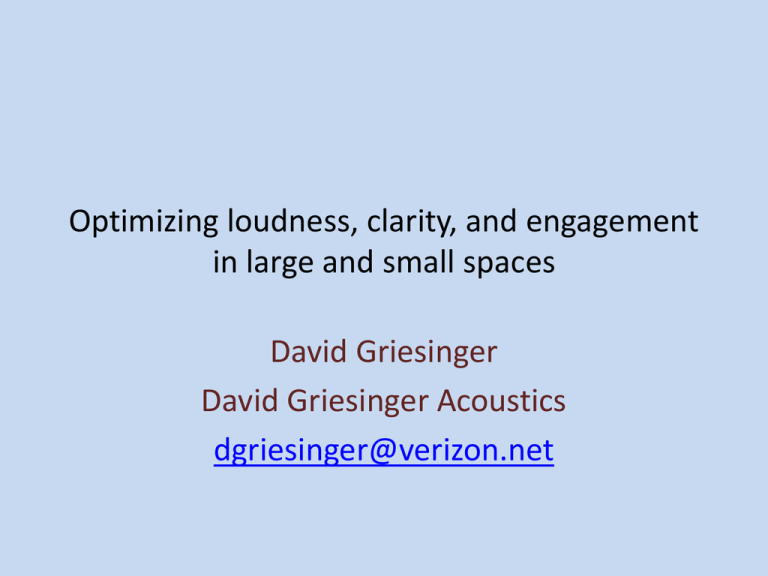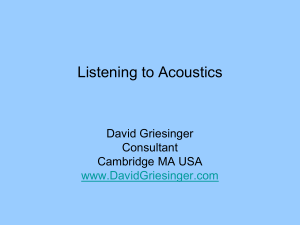Optimizing loudness, clarity, and engagement in
advertisement

Optimizing loudness, clarity, and engagement in large and small spaces David Griesinger David Griesinger Acoustics dgriesinger@verizon.net Introduction • We will start with a quick review of the physics and physiology behind our perceptions of clarity and envelopment, and how room acoustics affect them. • We will present a series of “rules of thumb” based on this knowledge. • Followed by a series of real-world examples of spaces where these rules can be applied – Along with many sonic demonstrations. Clarity and Envelopment • Clarity in this talk is a HIGH FREQUENCY phenomenon – 800Hz and above. – These frequencies carry information • Envelopment and reverberation are primarily beautiful at 500Hz and below, – with frequencies below 150Hz particularly important. • Understanding this frequency dependence is vital for understanding human hearing. High frequency retro reflectors Rectangular wall features scatter in three dimensions High frequencies are reflected back to the stage and to the audience in the front of the hall where they are enjoyed and absorbed. They are REMOVED from late reverberation – improving clarity for seats in the back of the hall. Examples: Amsterdam, Boston, Vienna High frequency overhead filters A canopy of disks or panels is a high frequency filter. Low frequencies pass through, exciting the full volume of the hall. High frequencies are reflected down into the front audience, where they are absorbed. In Tanglewood they reduce the HF reverberant level in the back of the hall, improving clarity. The sound is amazingly good, in spite of RT > 3s. (Ted Schultz) In Davies Hall they make the sound in the dress circle and balcony clear and reverberant. But the sound in the stalls can be harsh and elevated. The upper frequencies in voiced speech cut through noise and reverberation The syllable “one” voiced and then whispered, highpass filtered at 1000Hz, with equal RMS level. Voice and whisper in noise The syllables “one” to “four” voiced and whispered as the previous slide, with pink noise. Voiced speech in the formant bands has strong periodic peaks in the sound pressure. The ear has evolved to efficiently detect these peaks. But they are destroyed by excessive early reflections. Example of Clarity for Speech • This impulse response has a C50 and C80 of infinity. – STI is 0.96, RASTI is 0.93, and it is flat in frequency. In spite of high C50 and excellent STI, when this impulse is convolved with speech there is a severe loss in clarity. The sound is muddy and distant. (Click for sound ) The sound is unclear because this IR randomizes the phase of harmonics above 1000Hz!!! Once in every fundamental period the PHASE of the harmonics aligns to form a peak pressure. • Four phase-locked harmonics inside a critical band give a 6dB increase in signal to noise over a system that detects only one. • If this critical band is followed by a four tap autocorrelator there is another 6dB gain. • A 12 dB advantage in S/N is an enormous advantage to an organism! JASA - J. C. R. Licklider 1951 • Licklider proposed that our acuity of hearing could be explained by an autocorrelator located as close as possible to the hair cells. – Explaining our sense of pitch, and the rules of harmony. • This circuit exists – and it is directly below the hair cells. • Before signals are sent to the auditory nerve they have already been separated from each other by pitch. The Organ of Corti Contains ~3000 inner hair cells, ~15,000 outer hair cells, and ~60,000 spiral ganglia. The inner hair cells detect basilar motion, the outer hair cells control the membrane sensitivity, and the spiral ganglia autocorrelate. How do they work, and why are they needed? The autocorrelator in the organ of Corti also enables source separation • Which is essential to surviving parties and enjoying polyphony. • We can separate two simultaneous talkers from each other if their vocal pitches are different by as little as half a semitone! After separation by C and C# mixed pitch • Without the peaks created by the phases of harmonic tones we cannot separate or localize these signals. Clarity is the key to this talk – But we don’t know how to define it. – And current ISO measures fail to quantify it. Binaural impulse from BSH row R seat 11 Same, Row DD, seat 11 C80=C80 = 0.85dB IACC80 = .68 LOC = 0.21 IACC80 = 0.2 LOC = -1.2 9.1dB Both C80 and IACC80 predict the opposite of what we hear! This is how the ear perceives these seats with music: Boston Symphony Hall row R seat 11 The left channel of a binaural impulse response. LOC = 9.1dB Same, row DD, seat 11. The final sound level is almost the same, but in this seat it is mostly reflections. LOC = -1.1dB Note the window defined by the black box. We propose that if the area under the direct sound is greater than the area under the red line, the sound will be CLEAR. The ratio of these areas is LOC (in dB). What does this mean in practice? • Early reflections are desirable – but we must know when they become excessive! • We want the direct sound to be audible! • The ear logarithmically sums early reflections inside an 80ms window to detect the direct sound. • The earlier a reflection arrives the more it contributes to masking the direct sound. – Too many and the direct sound becomes inaudible. Classrooms to opera: where working memory is limited and clarity is essential. We also need loudness • First-order reflections almost never contribute to loudness – And when they do, the effect is usually undesirable. • In almost any large hall high order reflections dominate the loudness – But the brief appearance of the direct sound at the onsets of notes determines clarity Boston row DD, seat 11 Loudness is unchanged if we delete the early reflection at 15ms, and the Clarity improves markedly. Boston Symphony would be an even better hall if this reflection was eliminated! Envelopment • Envelopment is a perception. – It depends on how the brain interprets sound streams, not only by the spatial properties of the reverberation! • Envelopment is perceived when the ear and brain can detect TWO separate streams: – A foreground stream of direct sound. – And a background stream of reverberation. • Both streams must be present if sound is perceived as enveloping. – In the rear of most halls there is only one stream, combining foreground and background. – The sound is frontal and muddy. • Envelopment requires High Frequency Clarity, and Low Frequency Glate Boston row R seat 11 Direct sound only Reverb only Direct and Reverb mono Envelopment depends on Glate, • In too many halls nearly all the first-order reflections are directed to the audience, where they are absorbed. • There is too little energy left over for reverberance. • In seats close to the orchestra a few lateral reflections are desirable, but reflections from above are not helpful. • In seats farther away loudness is dominated by multiple reflections. Strong medial reflections only reduce clarity and envelopment. What causes Clarity and Envelopment to fail? • Clarity and envelopment fail three ways: – 1. Too many early reflections randomize phases at the onsets of sounds. • Solution: Use LOC or live speech measures to find where seats fail. – 2. Reverberation from a previous sound masks the onset of a succeeding sound. • Solution: Control the RT and reverb level to match the music. – 3. Upward masking from excessive low frequencies masks vocal formants.. • Solution: Control bass boom! • World Class Acoustics depends on minimizing all these problems! Rule of thumb #0 • Instruments radiate forward, voices radiate forward, and 1000 years of performance practice dictates that audience and performers should face each other. – Live performances live by human contact between performers and audience. • You need to be able to see faces and fingers. – Putting audience behind the performers breaks this essential aspect of the experience. • Do not put audience behind the performers! Rule of thumb #1 • Make the direct sound audible: – Bring the audience close to the performers – Enhance early lateral reflections in the front of the hall while limiting or eliminating the earliest reflections in the rear of the hall. • Rectangular niches and coffers can do this without absorption. – Control masking from excessive RT in smaller venues by reducing the reverberant level, not necessarily the RT. • The traditional absorptive stage house is underutilized in modern designs. • Audible direct sound is particularly important in Classrooms! – An early reflection coming within 5ms of the teacher aids clarity – but anything later than 8ms reduces it. Rule of thumb #2 • Maximize Glate without compromising clarity. – Modern designs use reflective surfaces to direct the first order reflections down into the audience. • This energy is absorbed. It reduces clarity, and does not contribute to late reverberation or envelopment. – So: Maximize the number of surfaces that can direct sound into regions where it bounces around before hitting people. • This will increase Glate while increasing clarity and preserving loudness. – Bare walls above the audience will contribute to late G by giving sound some space to relax before it comes down. • The walls need to have just the right amount of diffusion Rule of thumb #3 • Maximize the clarity and visual coherence of sound reinforcement – Reproducing sound through multiple sources reduces clarity. • Ideally a single loudspeaker should be within five feet of the talker unless the reinforcement is much louder than the natural sound. • But almost always the visual-audio connection is lost. • When reinforcing an ensemble do not combine multiple performers into a single speaker. – The usual practice of mixing to mono and reproducing through multiple speakers is disastrous to clarity. • Use directive loudspeakers with linear phase response from 800Hz to 4kHz wherever possible. Rule of thumb #4 • Control reverberation in the stage house – Multiple reflections inside the stage house reduce clarity. • They eliminate clarity before the sound can escape, and make it hard for musicians to hear each other. • Avery Fisher hall shows what not to do! – First order reflections from the stage should go out into the hall • preferably into areas where they contribute to late reverberation. – Good examples: Stage houses in Boston, Vienna, and Amsterdam Examples of Excellent Venues Epidaurus: D/R ~+4dB Spoleto: Teatro Caio Melisso: > 15,000 seats, Clarity A+ Festival dei Due Mondi Front row first balcony Boston ~350 seats, D/R > 0, A+ (N. F. Declercq) Symphony Hall. ~2700 seats D/R < -10dB, Clarity A+ after and before renovation Staatsoper Berlin 1500 seats, A+ acoustics Jordan Hall, New England Conservatory 1200 seats A- acoustics Epidaurus • Analyzed by N. F. Declercq ,15,000 seats D/R +4dB, Clarity excellent. – The low level of reverberation comes from seats and listeners sitting behind you. – The D/R of +4dB is identical to the D/R in almost all commercial recordings. – The performers receive just the right amount of late reverberation back from the audience. Spoleto: Teatro Caio Melisso • ~350 seats. Built in the 17th century, rebuilt in the 19th century. – Audience close to the performers – Stage house relatively absorbent – Late reverberation provided by high ceilings above the audience • Scott Nickrenz, the music director of the Festival dei Due Mondi proclaims this as the ideal venue for chamber music of all forms. Boston Symphony Hall • Not every seat is superb, as much of the audience is too distant. But every seat in this picture is spectacular. – The high coffered ceiling directs high frequencies to the front of the hall, increasing clarity in the rear. – The stage house is wide, shallow, high, sharply angled outward, and much of the back surface is absorbent. – Articulated parallel surfaces above the balconies maximize Glate. Staatsoper Berlin • 1500 seats, RT ~1s, Clarity excellent. – 20 years ago we added a Lares system that raised the RT at low frequencies to 1.7s, while limiting the RT and the reverberant level above 500Hz. – The system preserved the clarity while providing loudness and richness to the orchestra, and has been used (secretly) in every performance since. Jordan Hall, New England Conservatory • A world renowned 1000 seat chamber music hall. – Theater design brings audience close to the performers. – High ceiling adds late reverberation. • Clarity is excellent in almost all seats if the musicians are on the forestage. – The stage house is problematic, too deep, too reverberant. But this is still one of the finest small halls I know. • The hall sounded better in its original configuration, with a 460 square foot absorptive curtain above the proscenium. Opera Houses that work Bayreuth Vienna Your local multiplex • Bring the audience close to the performers • Limit the reverberant level to not obscure the words and the direct sound. • Have a long and distinguished history. • Opera was made for these houses. But in spite of 100 years of acoustic science the majority of new halls, opera houses, and lecture rooms are sonically mediocre. With eyes closed the sound is weak, muddy, or both. Too much audience is behind the musicians, and many instruments cannot be heard. In modern opera houses the words are mostly inaudible. Too much audience behind the performers • All these halls violate Rule of thumb #0 – And all have poor loudness and low late G An opera without words is just a silent movie. Oslo – front second balcony BOslo – standing room A Staatsoper Berlin, back of stalls, Sound very good – ( A ) Schiller Theater – (Staatsoper) Front of balcony B(C- further back) Copenhagen, middle of stalls, C- Walkure in HD – middle of theater sound A+ Calderwood Hall, Boston • Scott Nickrenz had requested that the new hall resemble the Teatro Caio Melisso. This is what he got. – Half the audience is behind the musicians. – There is a glass window that prevents anyone in the balconies from hearing the direct sound unless they lean uncomfortably over the rail. • At which point vertigo sets in. • Women in the balconies should not wear dresses. Carnegie Hall • Suffered greatly when the proscenium curtain and the stage fabric was removed. – The sound is now over-bright, muddy in many places – And often with disturbing echoes. • The old curtain and stage fabric eliminated the echoes, increased the D/R, and made the sound warmer and richer. – Sigh… Avery Fisher • • • • • The stage house is too large, too deep, and too reverberant. Instruments not on the forestage are muddy before anyone hears them. The ceiling is flat and not coffered. The balcony fronts increase the early reflections in the rear of the hall, just where the reflections should be reduced. Clarity is poor or non-existent for seats more than 1/3 of the way back. It is apparently going to be rebuilt, but with current practice it is unlikely to sound better. What can we do? • Bring the audience closer to the musicians In a long high ceilinged shoebox with an RT of over 2 seconds, we recommended putting the musicians in the center of the long wall, and adding absorption behind them. There was a dramatic improvement. Add absorption to existing stage houses Absorptive panels around the back of this stage transformed this hall from muddy to a delightful place for chamber performance. Try out my measure that quantifies Clarity from live speech using a model of hearing Signal at the output of a 4 tap correlator. Same but with randomized phase. The difference in peak amplitude of these two signals can be used as a real-time measure of clarity. Example: The numbers 1 to 10 repeated four times with increasing clarity. – All the sequences have C50 = infinity and STI > 96. Click for sound Measured Clarity in a Classroom • Harvard Science Center C: ~200 sharply raked seats. Large muticellular horn speaker. – Students in the rear were chatting to each other and playing with their smart phones. Why? Results: Clarity ratios with live speech Clarity with no microphone in the front of the hall. In the rear of the hall with no microphone. In the front of the hall with the microphone. In the rear with the microphone. Amplification reduces clarity. Don’t forget about stage curtains • Williams Hall at New England Conservatory has ~300 seats and is very reverberant. – But piano performance is beautiful because of the absorbent stage. Conclusions • ISO3382 analyses for Clarity are based on obsolete theories of hearing. The evolution of the ear and brain demands that the direct sound be audible. • Current hall designs are turning live performances into spectacles for tourists, driving audiences to movies and recordings. • Current classroom design and sound reinforcement strive for loudness over engagement, understanding, and remembering. • The ancient Greeks knew better. John Bradley’s critique of EDT Jordan’s original definition of EDT used two points. He thought of EDT as a method of determining the direct to reverberant ratio (D/R). Schroeder misunderstood the purpose of the measure, and redefined it using linear regression. As currently used EDT ignores the direct sound. EDT is a widely quoted international standard. It is not at all clear what it means perceptually, as the earliest reflections are bound to the direct sound.









